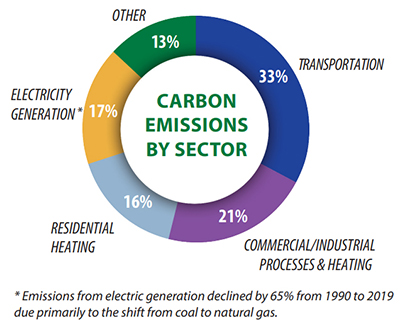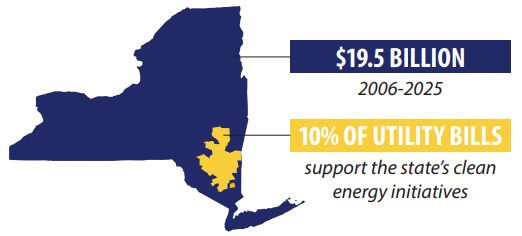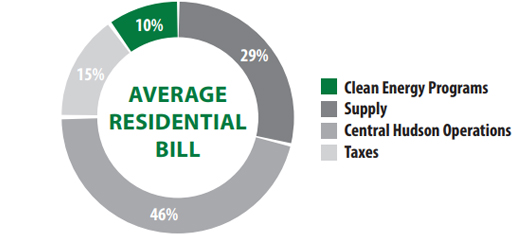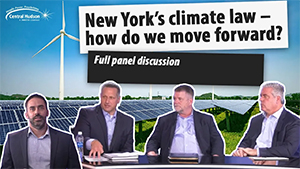
Energy in Transition
How quickly can we transition to an energy system that protects the environment without compromising highly consistent and reliable service at a reasonable cost?
New York is on an ambitious path to reduce greenhouse gas emissions by the way we use energy. With the likelihood of increased costs to fund the initiatives that will drive much of this change, energy users should have a clear understanding of what is planned.
Residents and businesses should be aware of the changes that are coming and help shape the transition by contacting your state legislator or contacting the Governor's office if you have thoughts about how these changes may affect you.
Climate Leadership & Community Protection Act (CLCPA)
Enacted by New York: 2019
Goal: Slash emissions to protect the environment and establish New York as a national leader in combating climate change.
Scoping Plan: Developed by the 22-member Climate Action Council, and led by the New York State Energy Research and Development Authority and the New York Department of Environmental Conservation. View the scoping plan at Scoping Plan - New York's Climate Leadership and Community Protection Act (CLCPA).
Concerns: Prescriptive measures and tight timeline limit options for power generation; significantly raise costs; potentially jeopardize grid integrity; eliminates use of natural gas.
Targets:

According to the CLCPA, wind, solar and battery storage must increase 18 times, or the equivalent of nearly 1,000 new large-scale facilities. In addition, the scoping plan assumes availability of on-demand generation using as-of-yet undeveloped fuels as backup to provide consistent power at all times, since renewables are weather dependent and therefore intermittent.
Central Hudson's Position
- Central Hudson agrees that emissions must be reduced to protect the environment.
- This must be accomplished affordably while also maintaining the integrity of the grid, preserving our economic base and meeting our current and future energy needs.
- New York's climate laws, while laudable, may have unintended consequences that raise costs and compromise energy availability.
- Central Hudson, as well as many other stakeholders, offer recommendations on how we can move forward in reducing emissions while ensuring a robust, affordable and viable energy system.

Central Hudson's 4 Principles for a Successful Energy Transition
|
|
PRINCIPLE 1: |
|
|
PRINCIPLE 2: |
|
|
PRINCIPLE 3: |
|
|
PRINCIPLE 4: |
At Central Hudson, we appreciate our responsibility to follow sound environmental, social, and corporate governance standards. We are actively committed to a cleaner energy future while continuing to provide reliable, resilient, and affordable power. Central Hudson is making investments in infrastructure, technologies, and programs that cost-effectively reduce carbon emissions by:
- Upgrading electric transmission and distribution lines, including support for statewide transmission upgrades to deliver renewable energy sources to areas of high electric demand including the Hudson Valley and metropolitan area, and investments in the regional electric distribution system to facilitate greater levels of locally sited renewable generation;
- Pursuing the lowest cost approach to emission reduction by examining current incentives to determine which offer the highest value in lowering emissions;
- Integrating natural gas benefits for fast-start electric generation to complement intermittent renewable resources and as a substitute for higher-carbon petroleum-derived fuels used in heating and manufacturing;
- Expanding energy efficiency programs, the most cost-effective method to reduce emissions; and
- Advancing environmentally beneficial electrification, for example, promoting electric vehicles and heat pumps to lower emissions from transportation and building heating.
Central Hudson Presentation
This presentation covers Central Hudson’s views on how we can reduce emissions affordably while maintaining high service levels.
The Cost of Clean Energy
Financial Support for Clean Energy Goals:
 |
 |
What the Experts Say
NYISO
The New York Independent System Operator (NYISO) oversees the electric grid and energy markets in New York. The organization provides its professional views in grid operation and growing reliance on renewable energy in its recently released 2022 Power Trends Report. Excerpts from the report are noted here, with concerns over system reliability and its potential impact if not carefully managed:
|
"The New York grid faces unprecedented reliability challenges as the clean-energy transition gains momentum." - NYISO 2022 Power Trends, Page 34 |
|
"Until there are enough clean energy resources on the grid to replace the reliability services provided by fossil fueled generation, natural gas must continue to play an important role in meeting the energy needs in New York to maintain system reliability which supports the health, safety, and welfare of all New Yorkers." - NYISO 2022 Power Trends, Page 27 |
|
"Long-duration, dispatchable and emissions-free resources will be necessary to maintain reliability and meet the objectives of the CLCPA. Resources with this combination of attributes are not commercially available at this time but will be critical to future grid reliability." - NYISO 2022 Power Trends, Page 38 |
|
"As traditional resources deactivate and are replaced by new clean energy resources that are dependent upon weather conditions to supply the grid, the challenge becomes greater." - NYISO 2022 Power Trends, Page 6 |
|
"Simply deactivating existing generation without having new resources on the system capable of providing comparable attributes risks the ability to maintain a reliable electric system. Additional transmission capability will lessen constraints and maximize the potential contribution of these renewable resources to meet electric demand and achieve public policy goals." - NYISO 2022 Power Trends, Page 9 |
|
"As we have witnessed recently in other parts of the U.S., the efforts necessary to achieve electric system reliability, economic efficiency, and environmental benefits are interlinked. These endeavors can and must coexist in support of our power system, our economy, consumer interests, as well as the health, welfare, and safety of all New Yorkers." - NYISO 2022 Power Trends, Page 1 |
What Others Say:
|
"Making use of the (U.S. natural gas) infrastructure already in place could offer a prime route for speeding up and cost effectively making the considerable changes needed to fully decarbonize the energy sector – while also enabling a just transition for communities that have invested in and rely upon these systems." - Columbia Center on Global Energy Policy |
|
"The legislature, either through its silence or total lack of actions, has given this commission nearly the exclusive responsibility to reach into New Yorkers' pockets to pay for the CLCPA mandates." - John B. Howard |
|
"Given these significant impacts to consumers, in addition to the other costs that will flow from the enormous infrastructure buildout required by the CLCPA, no Scoping Plan can reasonably be considered without the requisite cost analysis that shows practical impacts on consumers and how to afford paying them. ... All emissions-reduction technologies should be considered, and bans on existing types of facilities and appliances should not be imposed, especially where such bans would sacrifice reliability, resiliency and cost efficiency." - Independent Power Producers of NY, Business Council of NY, NYS AFL-CIO, NYS Building & Construction Trade Council: Advancing New York's Clean Energy Goals |
|
"Lower CO2 emissions (in the United States) have largely been a result of a shift from coal to natural gas in the electricity generation mix." - U.S. Dept. of Energy, Energy Information Administration |
Additional Resources
Power Trends 2023 report
New York’s climate policies are driving profound changes on the electric system. The New York Independent System Operator is at the forefront of this transition, working to achieve state emissions mandates with a balanced approach that maintains electric system reliability. It’s critical we prepare the power system for risks to reliability as we build the grid of the future, advance our economy, and support the health and safety of consumers.
- Media summary, Power Trends 2023
- Data sheet summarizing the Power Trends Report
- Full Power Trends 2023 Report
- Video presentation
- Information for policymakers, New York's clean energy transition
- Press release: NYISO study finds "reliability need" in 2025 for New York City region - NYISO
Utility Consultation Group
The Utility Consultation Group (UCG) is represented by New York’s gas and electric utilities, and is focused on providing expertise and perspective to the Climate Action Council and its advisory panels.
- UCG online info center
- UCG comments on the State's draft scoping plan
- UCG comments by sector summarized
Joint Statement: Advancing New York State's Clean Energy Goals
This statement was developed by the Independent Power Producers of New York, the Business Council of New York, the New York State Chapter of the AFL-CIO and the New York State Building & Trades Council.
NY CLCPA Website
Climate Act website: climate.ny.gov.
Renewable Electricity in New York State, August 2023
Prepared by the New York State Comptroller’s office, the report outlines the history, status and challenges in meeting the state’s clean energy mandates as well as anticipated costs of future investments.
NYS Dept. of Public Service: First Informational Report on Overall Implementation of the CLCPA, July 2023
A summary of costs and emissions reductions as a result of steps taken to meet the state’s clean energy mandates. According to the report, authorized funding to date amounts to about $43 billion, plus billions of dollars in future investments and incentives.
Dept. of Public Service White Paper
NY's Climate Law: How Do We Move Forward?

This video features a panel of leading New York energy specialists discussing New York’s climate law and providing their views on how we can move forward.
NYISO Video Series
The New York Independent System Operator (NYISO) oversees the electric grid and energy markets in New York. They created these videos that help New Yorkers understand the important changes and challenges ahead.
Episode 4: Preparing for Climate Change
New York State’s nation-leading grid decarbonization requirements have set the stage for 70% renewable energy by 2030 and a zero-emissions electric grid by 2040. At the same time, we currently face unprecedented impacts from climate change, creating issues of electric system resilience and future reliability. Meeting these challenges requires engineering innovation, investment in infrastructure, and new technology research and development to maintain the reliability we have come to rely on for our livelihood and our economic strength.
Episode 3: Keeping the Lights On
In August of 2003, a combination of transmission line outages and communications failures in the Midwest led to one of the largest blackouts in U.S. history, plunging much of the eastern seaboard into darkness. Episode 3 looks at lessons learned from previous outages and steps taken to avoid a similar event from happening in the future. The episode also looks at impacts of major weather-related events, like Hurricane Sandy, and the steps taken to address more frequent extreme weather in the future related to climate change.
Episode 2: How Reliability Happens
As we move to an emissions-free grid by 2040, the intermittent nature of clean energy resources creates significant challenges. Meeting the strictest reliability rules in the nation and keeping the lights on for all New Yorkers will require new technologies, changes to our wholesale competitive energy markets, and new approaches to managing the grid.
Episode 1: The State of the Grid
For well over a century, electricity has been vital to the growth of the U.S. economy. Today, the way electricity is being produced and consumed is changing. In New York, the Climate Leadership and Community Protection Act (CLCPA) calls for a zero-emissions grid by 2040. To get there, we’ll need new technologies and the adoption of new regulatory policies.
Lessons Learned
We can learn from recent experiences here in New York, other states and across the globe:

New York:
Following Indian Point closure, carbon emissions and prices rise. Natural gas usage in August 2022 set a record on multiple days in Central Hudson service area, the first time gas usage records were set in the summer. Wind lulls and cloud cover curtailed renewable production for periods in the winter and summer of 2022, and led to nearly exclusive reliance on natural gas, nuclear and large hydro for power supplies. The underground, under-river Champlain Hudson power line set to bring renewable electricity from Canada to New York City, receives opposition from environmental organizations and delays from local communities.

New York & New England:
Natural gas supply restrictions. Caused by constraints in pipeline capacity and denial of projects, resulting in higher costs and even prompting imports of liquified natural gas into New England.

Texas:
Inadequate grid redundancy. Both conventional and renewable generator failures. Widespread power outages during winter cold snap.

California:
Rolling blackouts. Re-thinking renewable-only buildout. Postponing retirements of certain natural gas and nuclear plants to ensure system integrity.

Germany:
Expansive solar and renewable buildout and closure of nuclear plants resulted in high energy costs and intermittency issues. Access to natural gas is limited, so reactivating coal plants to reduce costs and improve reliability. Curtailment and high cost of natural gas supplies as a result of actions taken by Russia may lead to rationing, which will harm industries, businesses and residents.

Europe:
Current energy crisis. Energy shortages and high prices as a result of restrictions to natural gas supply, brought about largely by the Russian-Ukranian conflict.

Emissions reductions, United States:
Natural gas has now surpassed the use of coal for electricity generation in the United States. Largely as a result, and with a rise in renewable resources, emissions from power generation nationwide have declined by about 33% from 2007 to 2019 according to the U.S. Dept. of Energy's Energy Information Administration.

Japan:
The Japanese government is investigating the potential to develop smaller nuclear reactors, announced at a national green transformation conference.


